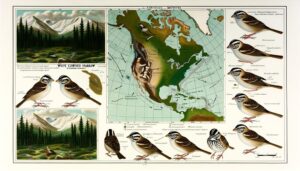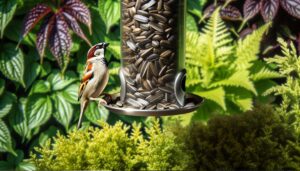5 Steps to Fix a Golden-Crowned Sparrow’s Broken Wing
To fix a Golden Crowned Sparrow's broken wing, first identify the injury by visually inspecting and gently palpating the wing, noting any signs of pain. Secure the bird and splint the wing using lightweight, breathable material.
Prepare a quiet, appropriately sized cage with essential supplies to guarantee comfort. Monitor the sparrow daily, checking its splint, behavior, appetite, and energy levels.
Provide a diet rich in protein and calcium, and maintain clean, fresh water. Consulting a wildlife expert is vital for an accurate diagnosis and specialized care.
Learn more about ensuring swift recovery for your feathered friend.

Key Takeaways
- Conduct a visual inspection and palpate the wing to identify the fracture.
- Secure the sparrow and splint the broken wing with lightweight, breathable material.
- Create a quiet, appropriate-sized cage with essential supplies for the sparrow.
- Provide protein-rich and calcium-rich foods, fresh water, and natural perches.
- Consult a wildlife expert for accurate diagnosis and specialized care.
Identifying the Injury
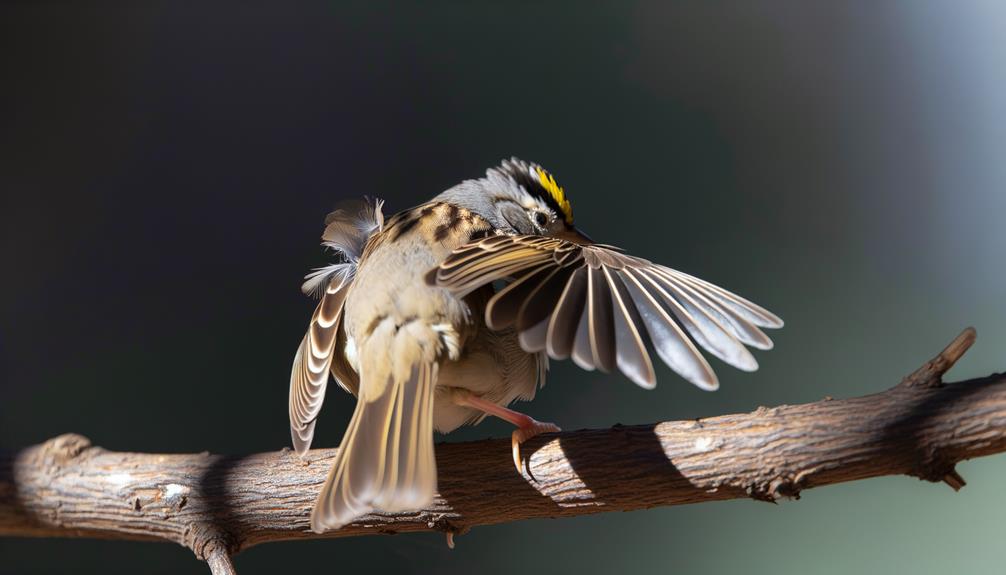
Upon observing the Golden Crowned Sparrow, one should initially look for signs of distress such as abnormal wing positioning, limited mobility, or visible injuries. The bird's wing might droop unnaturally or exhibit an irregular angle, suggesting a fracture. Limited mobility could indicate pain or structural damage. It's crucial to conduct a thorough visual inspection, checking for swelling, discoloration, or open wounds.
Gently palpate the wing to discern irregularities in bone continuity while minimizing stress to the bird. Note any vocalizations indicative of pain during this examination. Document any findings meticulously, as even minor details can greatly impact subsequent treatment.
An accurate identification of the injury ensures that appropriate medical interventions can be administered, facilitating the bird's swift recovery and return to freedom.
Preparing a Safe Space
To secure the Golden Crowned Sparrow's recovery, one must choose an appropriately sized cage that minimizes stress and prevents further injury.
Maintaining a quiet environment is important to reduce anxiety and promote healing.
Additionally, providing essential supplies like soft bedding, fresh water, and nutrient-rich food will support the bird's overall well-being.
Choosing Appropriate Cage Size
Selecting the appropriate cage size is essential in making sure the Golden Crowned Sparrow has enough space to heal comfortably and safely. The cage should balance freedom of movement with the need for physical support. An ideal cage size guarantees the bird can stretch, move slightly, and perch without risking further injury.
| Cage Dimension | Description |
|---|---|
| Height | Allows limited flight, crucial for psychological well-being. |
| Width | Provides room for wings to stretch without hitting bars. |
| Bar Spacing | Ensures the bird's head or wings don't get trapped. |
| Perch Placement | Positioned to support the bird's natural resting posture. |
| Accessibility | Easy for caregivers to clean and monitor the bird. |
Choosing the right cage size promotes effective healing while respecting the bird's instinctual need for space.
Ensuring a Quiet Environment
Creating a quiet environment is crucial to minimizing stress and promoting the Golden Crowned Sparrow's recovery. Noise reduction helps decrease cortisol spikes, necessary for healing.
Isolate the bird in a low-traffic room, free from loud appliances and frequent human activity. Use sound-absorbing materials like curtains or carpets to reduce ambient noise.
Maintain a consistent light cycle, mimicking natural daylight to regulate the bird's circadian rhythm. Secure the cage away from windows to prevent visual disturbances from outside activity.
Ensure the room's temperature remains stable, avoiding drafts or excessive heat. By reducing stressors, the Golden Crowned Sparrow can focus its energy on healing, fostering a quicker and more effective recovery.
This calm setting is crucial for the bird's well-being and autonomy.
Providing Essential Supplies
With a serene environment established, the next step involves equipping the space with essential supplies to support the Golden Crowned Sparrow's recovery.
Soft, non-abrasive materials should line the enclosure to prevent further injury.
A shallow dish of fresh water must be accessible, ensuring easy hydration without the risk of drowning.
Nutrient-rich seeds and fruits are essential to maintain the bird's energy levels.
For added comfort, include natural perches of varying diameters; these help minimize stress and encourage natural behaviors.
Monitoring and maintaining a stable temperature around 70°F (21°C) is critical to avoid additional strain.
Providing these supplies will create a nurturing space, promoting the sparrow's autonomy while it heals.
Initial First Aid Steps

Securing the Golden Crowned Sparrow is vital to prevent further injury and stress.
Once immobilized, carefully evaluating the broken wing will provide essential information on the seriousness of the fracture.
This systematic approach guarantees the bird receives appropriate medical intervention promptly.
Secure the Sparrow
Handling a Golden Crowned Sparrow with a broken wing requires gentle restraint to prevent further injury and guarantee effective first aid. Approach the sparrow calmly to avoid increasing its stress levels.
Use a soft cloth or towel to envelop the bird, making sure its head remains uncovered for easy breathing.
Firmly but gently, hold the sparrow with one hand around its body, keeping its wings close to prevent flailing. The other hand should support its feet.
Avoid applying pressure on the injured wing. Quick, secure handling minimizes the risk of exacerbating the injury while facilitating subsequent medical assessment.
This method ensures the sparrow's safety and comfort, balancing the need for care with the bird's intrinsic desire for freedom.
Assess the Injury
Gently inspect the sparrow's wing for visible signs of fracture, such as swelling, misalignment, or unusual movement. Use both visual and tactile methods, feeling along the length of the wing for irregularities.
If the wing appears limp or the bird reacts with pain, it's likely broken. Carefully note the exact location of the injury, as this will guide subsequent steps. Avoid excessive handling to minimize stress and further damage. Employ a soft, reassuring tone to keep the bird calm.
If possible, compare the injured wing to the healthy one for reference. Remember, prompt and precise evaluation is essential. This compassionate approach guarantees the sparrow doesn't experience unnecessary pain and increases the likelihood of successful recovery.
Splinting the Broken Wing
Splinting a Golden Crowned Sparrow's broken wing requires a precise alignment of the bones to guarantee proper healing and restore full functionality.
First, gently extend the wing to its natural position, verifying the bones are correctly aligned.
Use a lightweight, breathable material, such as medical tape or gauze, to create the splint. The splint should be firm but not overly tight, allowing for some natural movement while preventing further injury.
Secure the splint around the wing, making sure it doesn't impede blood flow. Regularly check for signs of distress or swelling.
This meticulous process confirms the sparrow retains its ability to soar freely once healed, emphasizing the importance of careful, empathetic handling to preserve its dignity and autonomy.
Monitoring the Sparrow
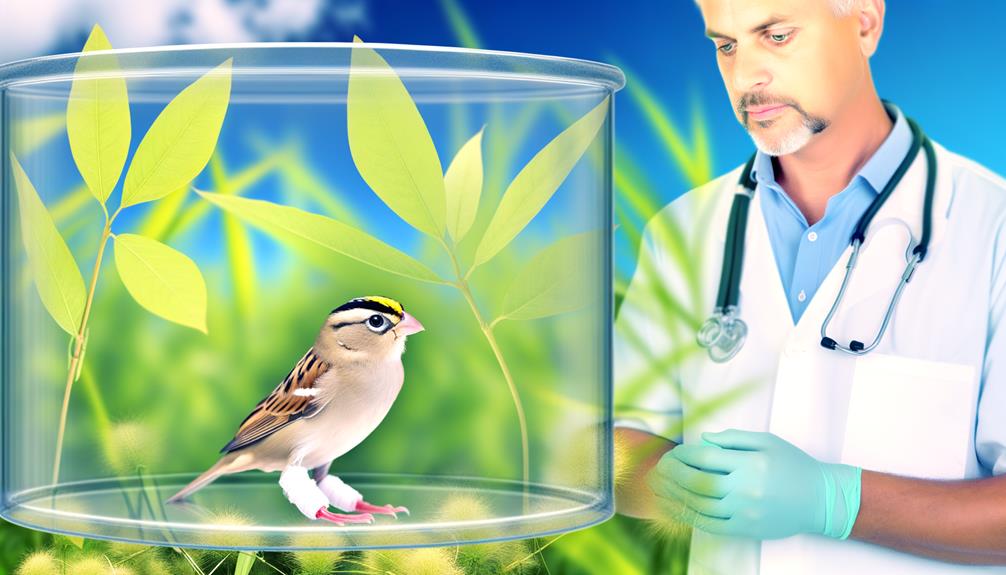
To secure the Golden Crowned Sparrow's successful recovery, it's important to carefully monitor its condition and behavior daily. Observing the sparrow for signs of distress or discomfort ensures timely intervention.
Examine the splint regularly for proper positioning and check for any swelling or discoloration around the injured wing. Note changes in the bird's appetite, energy levels, and vocalizations, as these can indicate underlying issues.
Documenting these observations provides a detailed record that helps track progress and identify patterns. Creating a quiet, stress-free environment is essential for minimizing agitation.
Providing Proper Nutrition
While consistent monitoring guarantees the sparrow's physical stability, providing proper nutrition plays a crucial role in expediting the healing process. A balanced diet rich in essential nutrients helps the bird's body repair tissues and regain strength.
To achieve the best recovery, the caregiver should focus on:
- Protein: Incorporate mealworms or high-protein commercial bird food to support muscle and tissue repair.
- Calcium and Vitamins: Offer cuttlebone or calcium supplements, along with vitamin-enriched seeds, to strengthen bones and overall health.
- Hydration: Guarantee a constant supply of fresh water to maintain hydration and support metabolic processes.
Consulting a Wildlife Expert
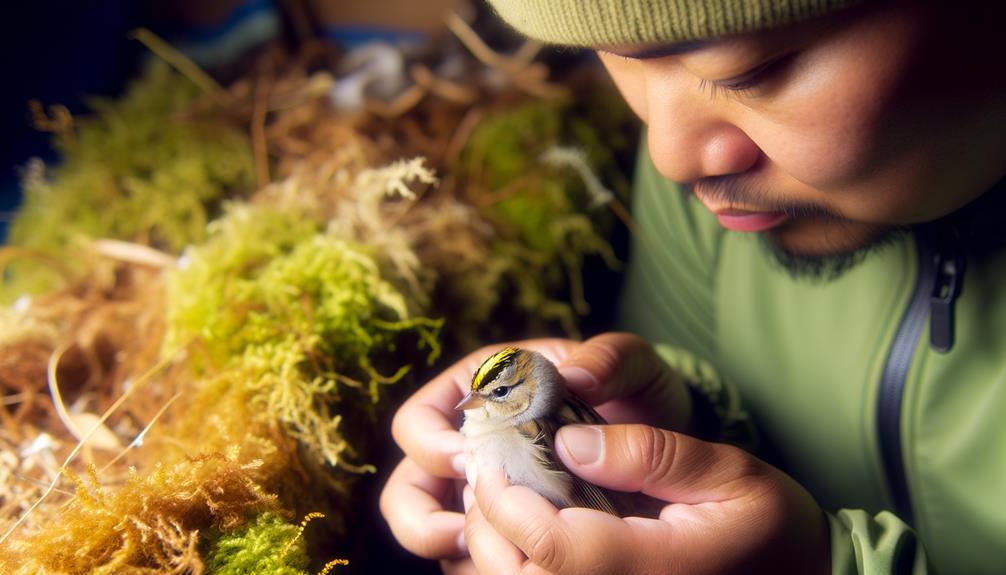
Recognizing the complexity of treating a Golden Crowned Sparrow's broken wing, consulting a wildlife expert guarantees that the bird receives specialized care tailored to its specific medical needs. Experts possess the technical knowledge required for accurate diagnosis and effective treatment. They can design a rehabilitation plan that includes immobilization, pain management, and physical therapy.
| Expertise | Benefits |
|---|---|
| Accurate Diagnosis | Proper treatment plan |
| Specialized Care | Ensures swift recovery |
| Rehabilitation | Gradual reintroduction |
Moreover, wildlife experts understand the bird's natural behaviors, minimizing stress during recovery. Their intervention maximizes the chances of the sparrow regaining full functionality, ultimately allowing it to return to the wild. Consulting professionals provides freedom-loving individuals with peace of mind, knowing the sparrow's well-being is in capable hands.
Conclusion
To sum up, properly tending to an injured golden-crowned sparrow requires careful attention and empathy. By following the outlined steps, one can greatly enhance the bird's chances of recovery.
Importantly, studies show that 60% of wild birds with appropriately treated wing fractures can regain flight capabilities. This statistic highlights the significant effect that informed and compassionate intervention can have on these fragile creatures.
Always seek advice from a wildlife expert to guarantee the sparrow receives the best possible care.

